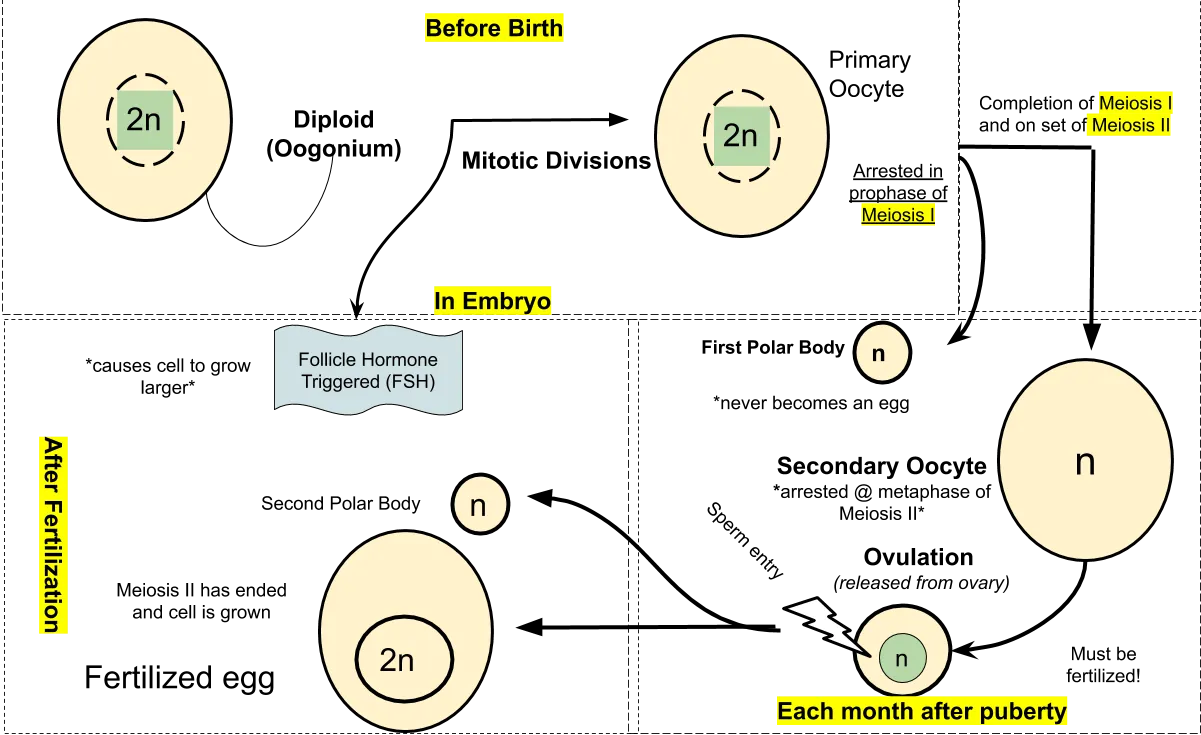If you read through my past posts, you would see that I have been writing on the the reproductive organ, and I started with the male reproductive organ, then I went on to discuss spermatogenesis. I also started writing on the female reproductive organ, and like I said that I will be doing the female germatogenesis which is Oogenesis. Spermatogenesis was relatively easy to discuss, or let me say the female reproductive organ is a little complex compared to the male reproductive organ. Let me quickly do a quick on on the male spermatogenesis. I said in the post that spermatogenesis begins with spermatogenium, then to primary spermatocyte, where meiosis 1 takes place to create the secondary spermatocyte, after which Meiosis 2 takes place to become spermatids, after which differentiation occur to become spermatozoa or matured sperm cells. I said that this entire process takes place in one cycle, with no stop in the process at any time.
With Oogenesis, the process is slower with lots of delayed or stalled period in the process. Oogenesis begins with an Oogonium to an Ovum. Not all daughter cells in Oogenesis are used, daughter cells like polar bodies aren't viable in the process and are degraded, and there are significant periods in Oogenesis where the cell cycle is halted during some meiosis cycle. While men make lots of sperm cell and expect that one of the sperm cell will make it to the egg, the female gamertogenesis doesn't work that way, as it doesn't focus on creating numerous eggs rather it creates just one while the rest are going to die. The only egg available is the egg that would be ovulated and fertilized if any fertilization takes place. Let's me state that depending on what reference you are using, the egg can be the Ootid, secondary Oocyte, or the Ovum.
Similar to Spermatogenesis, Oogenesis begins with the Oogenium which then divides assymetrically (mitosis) to give two daughter cells where one is the primary Oocyte while the other replenishes the Oogonium storage. The primary Oocyte begins primary Meiosis but doesn't complete meiosis 1 as it ends at prophase 1 (which is the first phase of all the four phases). The meiosis event occurs before puberty being known as Meiotic arrest. After meiosis 1, two daughter cells are formed in an asymmetric division and one of the cells will continue with the division becoming the secondary Oocyte (haploid cell), while the other daughter cell that isn't viable is known as the polar body which also has a copy of the chromosome that is viable. In Oogenesis, the energy and nutrient are focused on one cell for fertilization. Meiosis 2 begins with the secondary Oocyte but this process becomes arrested (meiotic arrest 2 in metaphase 2) and these becomes ovulated and that Oocyte can be fertilized if a sperm cell penetrates it. When the sperm cell injects its DNA into the secondary Oocyte, it completes Meiosis 2 then it divides into 2 daughter cell where the non-viable one is the polar body while the viable one is the Ootid (similar to the spermatid) but for a short period of time, then it becomes an Ovum which has two pronucleus where the male DNA is stored in the male pronucleus while the female DNA is stored in the female pronucleus. The pronucli are seperate, and when they fuse to become a true nucleus, a zygote is formed.
With Folliculogenesis, it has to do with the follicle development. The egg develops in the follicle, so they are both important and the follicle develops along side the egg and they need to synchronize. Folliculogenesis starts with squamous pregranulosa cells, which then develops into a primodial follicle which contains primary Oocytes, then it develops into a primary follicle which poccesses granulosa cell and still contains the primary Oocyte, then to a secondary follicle which is larger than the primary follicle and has a thick granulosa cell leyer and it pocesses Theca cells which plays an important role in Oogenesis as the produce the androstenedione and convert it to Estradiol where estrogen is produced and it still houses the primary Oocyte, and then it develops into a Antral/grafian follicle where the granulosa cells thicken, and then Cumulus cells develop with excessive space between the granulosa cell known as the antral cavity. The Antral/grafian follicle houses the secondary Oocyte which then starts meiosis 2 where it gets to metaphase 2 where it is arrested, waiting for day 15 of the female menstrual cycle which is Ovulation. During Ovulation, the Antral/grafian follicle ruptures, releasing the secondary Oocyte. The Oocyte is picked up by the fimbreae from the ovary where the Oocyte moves to the fallopian tube where it waits for a sperm cell, and if there is fertilization, it will finish meiosis 2 and mature into Ootid and Ovum, then to become a zygote. When there is no fertilization, meiosis 2 would not be completed, and the secondary Oocyte will be degraded.
Oogensis and folliculogenesis work hand in hand, and they are needed for the development of zygote. In my next post, I will discuss Zygotic Cleavage which is development of zygote to blastocyst.
https://byjus.com/biology/oogenesis/
https://bio.libretexts.org/Bookshelves
https://www.ncbi.nlm.nih.gov/pmc/articles/PMC7349727/
https://study.com/learn/lesson/oogenesis-process-what-is-oogenesis.html
https://www.bionity.com/en/encyclopedia/Folliculogenesis.html


